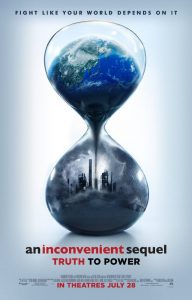REVIEW: A not so ‘inconvenient sequel’

On Nov. 4, as a part of its Film and Speaker Series, The Office of Student Life hosted ‘An Inconvenient Sequel: Truth to Power’.
The sequel is a continuation of the 2006 film ‘An Inconvenient Truth’, a documentary which displays former Vice President and presidential candidate Al Gore’s fight to raise awareness and inspire action to combat climate change.
As I sat in the lecture hall waiting for the film to begin, I could feel my weeks’ worth of late nights and early mornings catching up with me. Then the hall became pitch black and the film began. Somber music rose from the speakers and words began slowly appearing and disappearing from the screen. I began to fear the documentary wouldn’t be enough to keep me from falling asleep and offending the 55-75 year olds that made up the majority of the audience. I was wrong.
Not having seen the first film, I went into this with very few expectations. I made the, somewhat obvious, assumption that a film about climate change starring Al Gore would present the issue with a liberal slant, and I found this assumption to be mostly, but not entirely, correct.
The film was refreshingly not political, and I was pleasantly surprised by the lack of name calling and finger pointing toward conservatives and republicans. I appreciated the film’s brief acknowledgment of the economic struggle faced by developing countries in making the decision to switch to renewable energy sources. However, it predictably failed to present the conservative argument against fighting climate change.
Much of what the film discussed was centered around the negative impacts that climate change has on the world and the importance of creating legislation to fight it. However, it did not present the economic side of the issue or explain where the money to pay for the switch to renewable energy is coming from.
Despite the film’s obvious bias, I felt it did a wonderful job at appealing to the audience’s emotions. Unbelievable footage of recent natural disasters and weather changes, including the 2015 and 2016 flooding in Houston, paired with astonishing before and after shots of melting glaciers and snow effectively communicated climate change in a way that’s easy for anybody watching to understand. I also found myself, and the rest of the audience, laughing a lot more than one would expect from a watching documentary about climate change.
What I anticipated to be a dull documentary full of political attacks ended up being an enjoyable, eye-opening film that I encourage everyone to watch. If you’re like me, this film will probably leave you feeling guilty for every plastic bottle you’ve ever thrown away or light you didn’t turn off.
However, I think the real purpose of the film is not to create guilt, but to encourage us to put more thought into the effect that our actions have on the environment and to realize that the little things, whether good or bad, do add up.
To learn more, you can follow the #BeInconvenient movement on social media or visit pledge.inconvenientsequel.com and pledge to #BeInconvenient.

